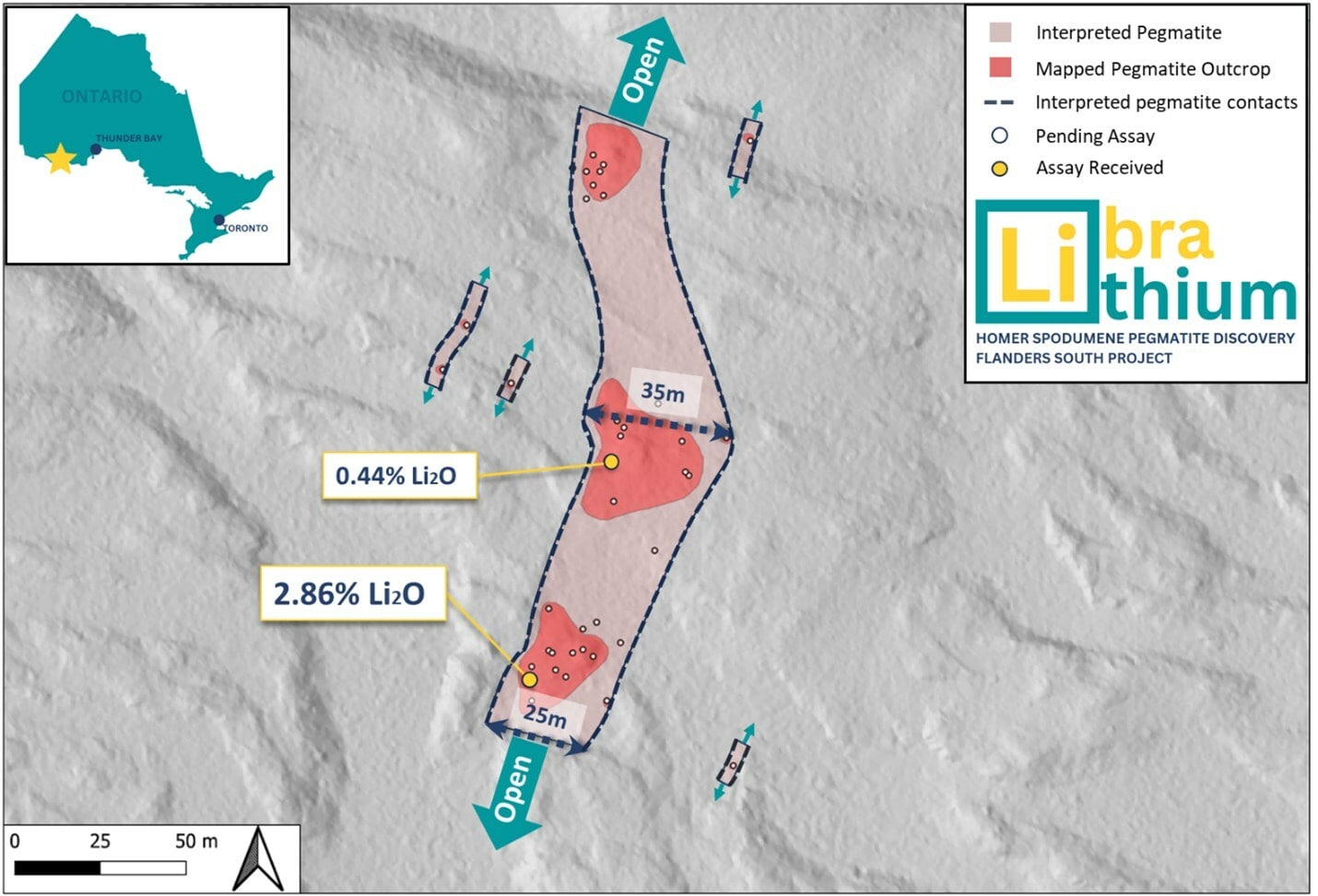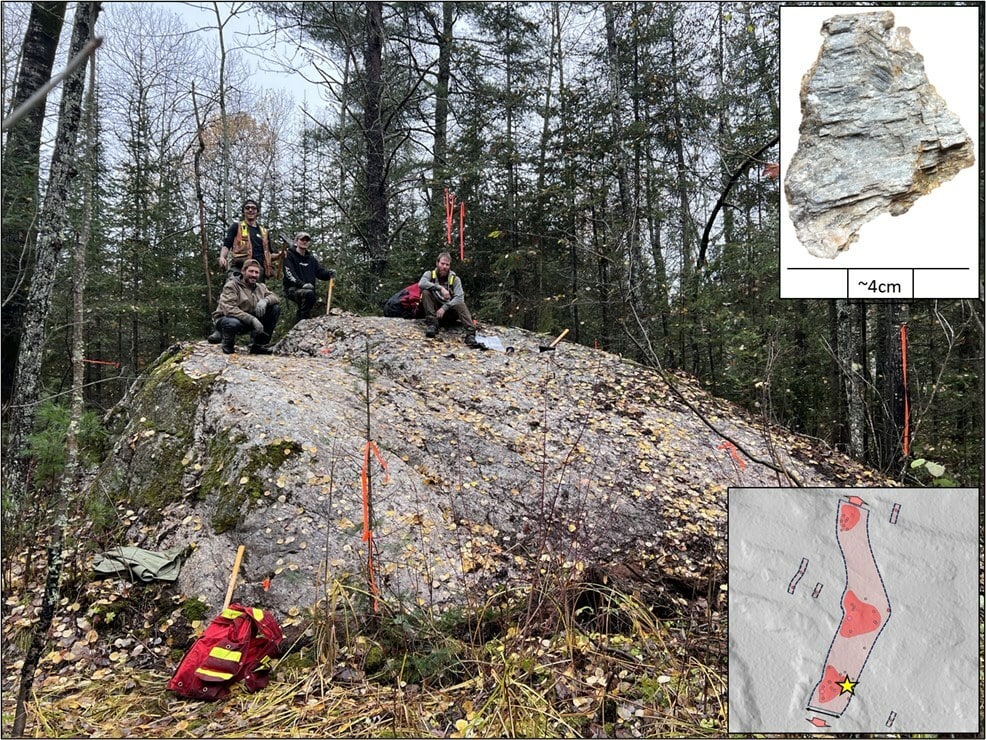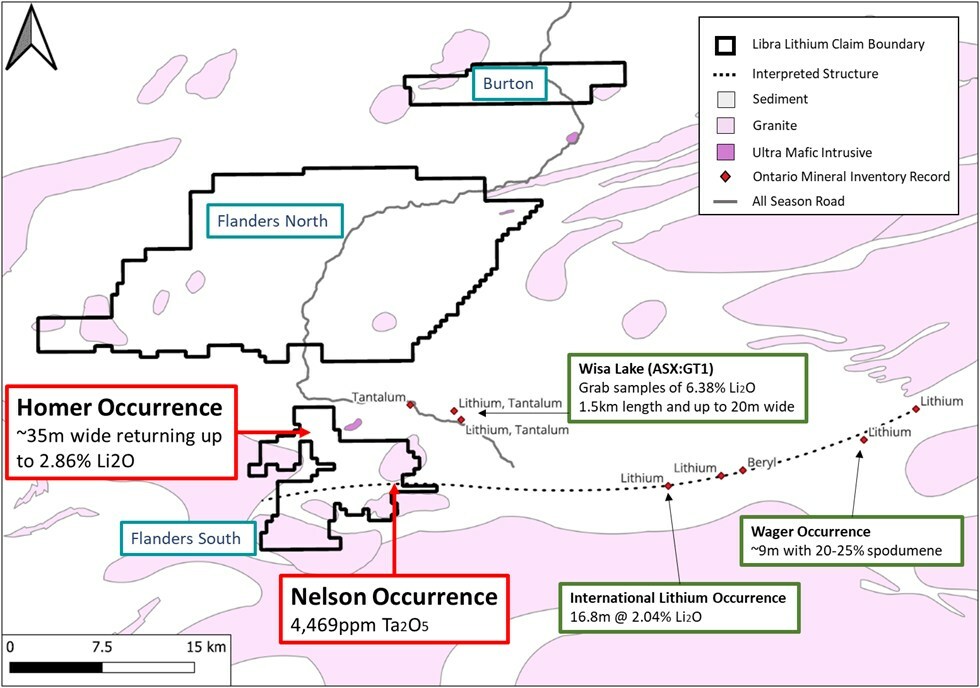Press Release
LIBRA LITHIUM ANNOUNCES GRASSROOTS SPODUMENE DISCOVERY, SAMPLES 2.86% LI2O WITHIN A 35-METRE WIDE PEGMATITE
TORONTO, Nov. 28, 2023 /CNW/ – Libra Lithium Corp. (“Libra Lithium” or the “Company“), a privately-held, critical minerals explorer, is pleased to announce the discovery of lithium mineralization at its 100%-owned Flanders South project in Ontario, Canada. Mineralization comes in the form of spodumene – a key lithium-bearing mineral – with surface grab samples returning up to 2.86% Li2O within the newly named Homer pegmatite, which spans up to 35 m in width and is located less than 3 km from an all-season road. With approximately 50,000 hectares in the Flanders District, Libra Lithium has secured a multi-kilometre trend of evolved pegmatites with anomalously high lithium values, and the Company looks forward to following up on several high-conviction targets as soon as weather permits.
Figure 1: Homer pegmatite discovery, showing grab sample assays, overlaid on topography generated from LiDAR survey. (CN Group/Libra Lithium)
Figure 1: Homer pegmatite discovery, showing grab sample assays, overlaid on topography generated from LiDAR survey. (CN Group/Libra Lithium)

Figure 2: Bayside Geoscience crew atop the Homer spodumene pegmatite discovery (left to right): Steve Greiner (top), James (bottom), Cameron Mitchell, and Carson Fraser; top-right picture shows spodumene crystal from Homer pegmatite. (CNW Group/Libra Lithium)

Figure 3: Overview map of Libra Lithium’s Flanders District projects and nearby mineral occurrences. 1,2,3,4 (CNW Group/Libra Lithium)
Highlights:
Coarse-grained spodumene was discovered within the Homer pegmatite, with surface grab samples returning up to 2.86% Li2O.
- The Homer pegmatite is exposed on surface for over 160 m and remains open along strike, with exposed widths of up to 35 m.
- Homer appears to be sub-vertically dipping, suggesting the mapped surface may represent approximate true widths.
- The pegmatite has not been fully stripped, with only one side of the contact between the pegmatite and the host rock identified thus far, indicating potential for the pegmatite to be larger than what is currently exposed.
- Adjacent pegmatites that have yet to be stripped share similar geochemical signatures to the Homer pegmatite, indicating potential for a stacked pegmatite system.
- Hundreds of pegmatite outcrops have been identified within the Flanders District, some of which have exposed widths of up to 200 m; most pegmatites remain untested.
- The Homer spodumene discovery was found near the end of the field season, following a systematic exploration program that utilized both modern technology, including LiDAR and laser induced breakdown spectroscopy (LIBS), and traditional boots-on-the-ground prospecting and sampling, to generate an in-house prospectivity model.
- The Flanders District projects, including Flanders North, Flanders South, and Burton, together comprise over 50,000 hectares; these projects were generated in-house, initially staked due to anomalous lithium-in-lake-sediment signatures within a favourable geological terrain; the mineral rights are 100%-owned by Libra Lithium, with no option payments or royalties due.
- The Company plans to return to the Flanders District in Q2/2024 to follow-up on high-ranking targets generated by Libra Lithium’s prospectivity model, in the hopes of discovering additional spodumene-bearing pegmatites.
- Assays from 200+ grab samples from Flanders South remain pending, with results expected in the coming weeks.
- Libra’s Flanders District projects are proximal to Highway 11 and are named after the all-season Flanders Road that transects the project areas; a network of logging roads exists off this road in addition to a power transmission line. “The Homer spodumene discovery is just the beginning for Libra Lithium. Its discovery is a true testament to our staking methodology, and we are proud to have the in-house expertise to generate our own projects. We have done everything in our power to keep our burn rate as low as possible, and I am impressed with how far our ~$1.9M raised since inception has taken us: from building a team, to purchasing equipment, to acquiring over 80,000 hectares of ground, to systematically exploring what is now one of Canada’s largest lithium project portfolios, to making our first grassroots spodumene discovery. A special kudos goes to our VP of Exploration, Ben Kuzmich, who first proposed the likelihood that the Flanders District hosts undiscovered spodumene-bearing pegmatites,” said Koby Kushner, CEO of Libra Lithium. “Homer is a genuine grassroots discovery. There are zero historical assessment reports on our Flanders claims, and zero previous records of
pegmatites on our claims – to our knowledge, we are the first company to walk over these pegmatites and systematically explore them for lithium. Initially, the only data we had to work off was regional geophysics and lake sediment geochemistry conducted by the Ontario Geological Survey. Given the minimal overburden in the region, we believed the Li-Cs-Ga-Sn lake sediment anomalies at both Flanders North and Flanders South could be representative of the bedrock geology. I would like to express my gratitude to the hard-working crew of geologists from Bayside Geoscience, including Stephen Greiner, Cameron Mitchell, Carson Fraser, and James Fisher who made this discovery possible” said Ben Kuzmich, VP Exploration of Libra Lithium.
Figure 1: Homer pegmatite discovery, showing grab sample assays, overlaid on topography generated from LiDAR survey.
Figure 2: Bayside Geoscience crew atop the Homer spodumene pegmatite discovery (left to right): Steve Greiner (top), James Fisher (bottom), Cameron Mitchell, and Carson Fraser; top-right picture shows spodumene crystal from Homer pegmatite.
Figure 3: Overview map of Libra Lithium’s Flanders District projects and nearby mineral occurrences.1,2,3,4
The Flanders South project comprises 8,711 hectares of ground, central within Ontario’s Quetico metasedimentary subprovince. The project was staked
in-house, meaning it is 100%-owned by Libra Lithium with no option payments or royalties due. The project is accessible via Flanders Road, an all-season gravel road off Highway 11, south of Atikokan and west of Thunder Bay.
Following a satellite imagery review, Libra Lithium conducted an airborne LiDAR survey to reveal pegmatite targets and structures across the Flanders District. The Company then contracted Bayside Geoscience to conduct a reconnaissance level prospecting and mapping program on Flanders South. Libra Lithium utilized a handheld LIBS analyzer to test the chemistry of pegmatite samples collected before sending them for laboratory analysis. The Libra Lithium technical team analyzed samples from other Ontario spodumene occurrences, testing the muscovite grains for lithium, potassium, and rubidium, to develop a prospectivity model based on LIBS readings. Applying this prospectivity model helped to discover spodumene at the Homer pegmatite. ____________________________
1 Mineralization hosted on adjacent and/or nearby properties is not necessarily indicative of mineralization hosted on the Company’s properties.
2 Ontario Mineral Inventory, Record MDI000000003311; http://www.geologyontario.mndm.gov.on.ca/mndmfiles/mdi/data/records/MDI000000003311.html
3 Ontario Geological Survey, Open File Report 5388; http://www.geologyontario.mndm.gov.on.ca/mndmfiles/pub/data/imaging/OFR5388//OFR5388.pdf
4 Green Technology Metals, Wisa; https://www.greentm.com.au/wisa-project
The Homer pegmatite outcrops at surface, and has been traced for a minimum of 160 m along strike, with exposed widths varying between ~25-35 m. One side of the pegmatite contact has been identified, indicating that the pegmatite is still open for expansion towards the other, buried, contact. The pegmatite trends approximately north-south and appears to dip sub-vertically. The pegmatite is zoned with local quartz pods and megacrystic feldspar, and contains cleavelandite, garnet, apatite, muscovite, tourmaline, and spodumene. Assays from two grab samples, located approximately 70 m apart, have been received, returning 2.86% Li2O and 0.44% Li2O, respectively. Other pegmatites, which have yet to be stripped, have been found directly adjacent to Homer, indicating potential for a stacked pegmatite system.
“The north-south orientation of the Homer spodumene pegmatite is somewhat unusual, as most pegmatites in the Flanders District trend east-west. Accordingly, we have been conducting our traverses in a north-south direction to transect the target pegmatites. Coupled with the fact that this was a first-pass program with widely spaced traverses, we believe it is highly likely that there are other north-south trending dykes remaining to be discovered,” said Andrew Jedemann, Exploration Manager of Libra Lithium, “We are eager to get back out there as soon as the snow melts. Meanwhile, we await results for the pending assays from 200+ grab samples at Flanders South.”
Quality Control
Due to the high degree of variability in the sampled pegmatites and granites, the reported grab samples may not be representative of the overall mineralization / characteristics of the bedrock. Grab samples were collected in the field with a hammer and were generally greater than 1 kg in weight. The grab samples were delivered by Libra Lithium geologists to ALS Geochemistry Thunder Bay prep labs. Samples were assayed by ALS Geochemistry, Vancouver analytical lab which is an ISO 17025 accredited laboratory and is independent of the Company. The samples were digested using a sodium peroxide fusion and assayed by ICP-MS for trace elements (i.e., ME-MS89L). ALS Geochemistry inserted standards, blanks, pulp duplicates and prep duplicates into the sample stream.
Qualified Person
Ben Kuzmich, M.Sc., P.Geo. supervised the preparation of the scientific and technical information that formed the basis for the written disclosure in this news release. Ben Kuzmich is the VP of Exploration for Libra Lithium and the Qualified Person (as such term is defined by National Instrument 43-101). He has verified the data disclosed in this press release, including the sampling, analytical and test data underlying the information. To verify the data related to the sampling program, he has discussed sampling procedures with responsible site staff; discussed and reviewed assay and QA/QC results with responsible personnel; and reviewed supporting documentation, including with respect to sample location and orientation.
About Libra Lithium Corp.
Libra Lithium is focused on advancing and developing a portfolio of grassroots lithium projects in Canada. Libra Lithium’s asset portfolio includes its 100%-owned Flanders North, Flanders South, Burton, Tennant, Battery Hill, Bitchu, Kivinen and Twist lithium projects, as well as an option to earn a 100% interest in the Soules Bay and Caron lithium projects. Together, these projects span approximately 80,000 ha of prospective ground near Ontario’s Thunder Bay Mining District. Libra Lithium also holds a 100% interest in the Nemiscau lithium project in James Bay, Quebec, where several pegmatites, up to 100m wide, have been mapped. Libra Lithium also holds a 10% interest in Blue Ridge Lithium Corp., a private company focused on defining lithium-brine resources in the Appalachian Basin. The Libra Lithium team comprises a mix of seasoned executives, engineers and geoscientists, with extensive experience in mining and mineral exploration, capital markets, asset management, energy, and First Nations engagement.
Koby Kushner, P.Eng., CFA
CEO & Director Reader Advisories
No securities regulatory authority has approved or disapproved the contents of this press release.
Certain statements contained in this press release constitute “forward-looking information” as such term is defined in applicable Canadian securities legislation. The words “may”, “would”, “could”, “should”, “potential”, “will”, “seek”, “intend”, “plan”, “anticipate”, “believe”, “estimate”, “expect”, “outlook”, and similar expressions as they relate to the Company, including, without limitation: all statements other than statements of historical fact may be forward-looking information; statements relating to the exploration results and whether such results are supportive of anticipated mineralization on the projects; prospects and timing for further exploration; future exploration activities, and the results, and the timing of results, thereof; and other Company objectives; are intended to identify forward-looking information. Such statements reflect the Company’s current views and intentions with respect to future events, and current information available to the Company, and are subject to certain risks, uncertainties and assumptions. Many factors could cause the actual results, performance or achievements that may be expressed or implied by such forward-looking information to vary from those described herein should one or more of these risks or uncertainties materialize. Examples of such risk factors include, without limitation: exploration results not being representative of mineralization on the projects, future exploration activities not being carried out, or if carried out, the results not being as anticipated, risks that the Company may not advance the projects, risks related to credit, market (including equity, commodity, foreign exchange and interest rate), liquidity, operational (including technology and infrastructure), reputational, insurance, strategic, regulatory, legal, environmental, and capital adequacy,
and other risks and uncertainties related to the Company’s prospects, properties and business; political and regulatory risks associated with mining and exploration activities and operations; the general business and economic conditions in the regions in which the Company operates; the ability of the Company to execute on key priorities, including the successful completion of acquisitions, business retention, and strategic plans and to attract, develop and retain key executives; the ability to implement business strategies and pursue business opportunities; low profit market segments; disruptions in or attacks (including cyber-attacks) on the Company’s information technology, internet, network access or other voice or data communications systems or services; the evolution of various types of fraud or other criminal behavior to which the Company is exposed; the failure of third parties to comply with their obligations to the Company or its affiliates; the impact of new and changes to, or application of, current laws and regulations; granting of permits and licenses in a highly regulated business; the overall difficult litigation environment; increased competition; changes in foreign currency rates; increased funding costs and market volatility due to market illiquidity and competition for funding; the availability of funds and resources to pursue operations; critical accounting estimates and changes to accounting standards, policies, and methods used by the Company; the occurrence of natural and unnatural catastrophic events and claims resulting from such events; and risks related to COVID-19. Should any factor affect the Company in an unexpected manner, or should assumptions underlying the forward-looking information prove incorrect, the actual results or events may differ materially from the results or events predicted.
Any such forward-looking information is expressly qualified in its entirety by this cautionary statement. Moreover, the Company does not assume responsibility for the accuracy or completeness of such forward-looking information. The forward-looking information included in this press release is made as of the date of this press release and the Company undertakes no obligation to publicly update or revise any forward-looking information, other than as required by applicable law.
SOURCE Libra Lithium
For further information: [email protected]
